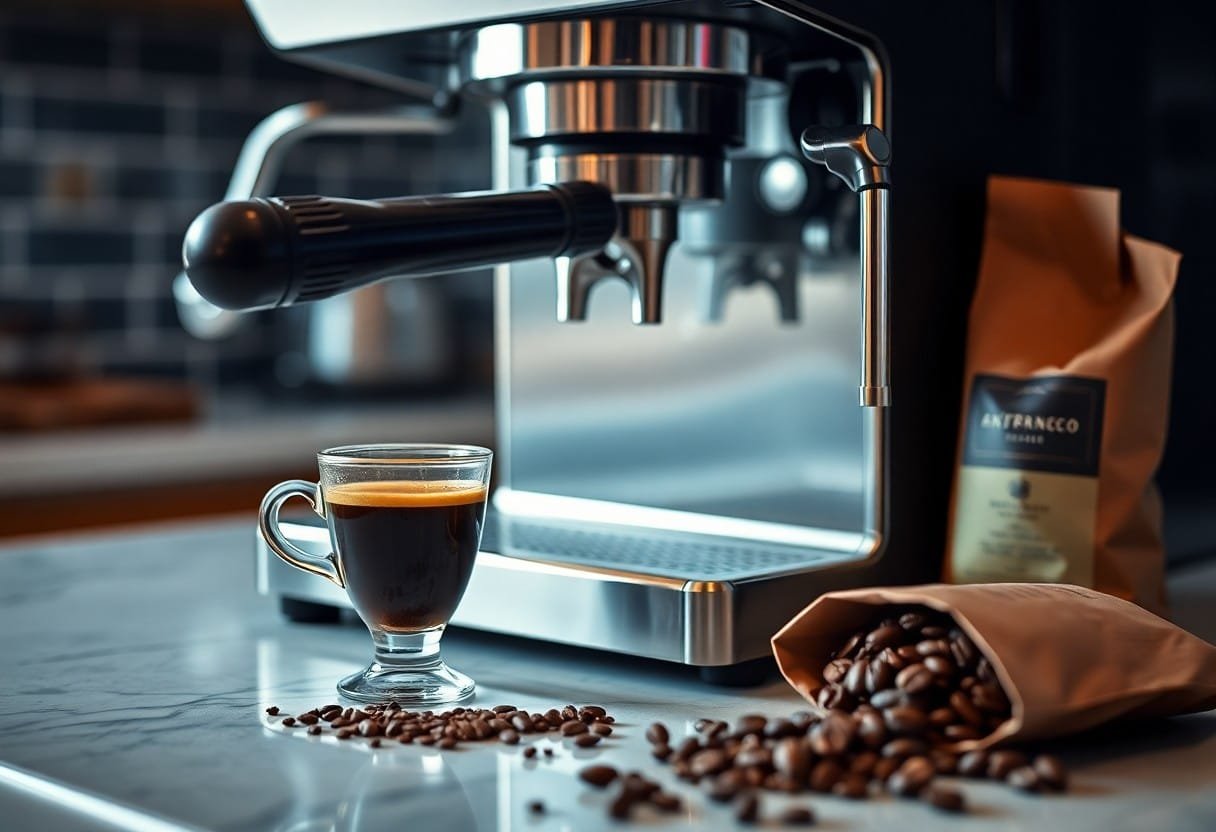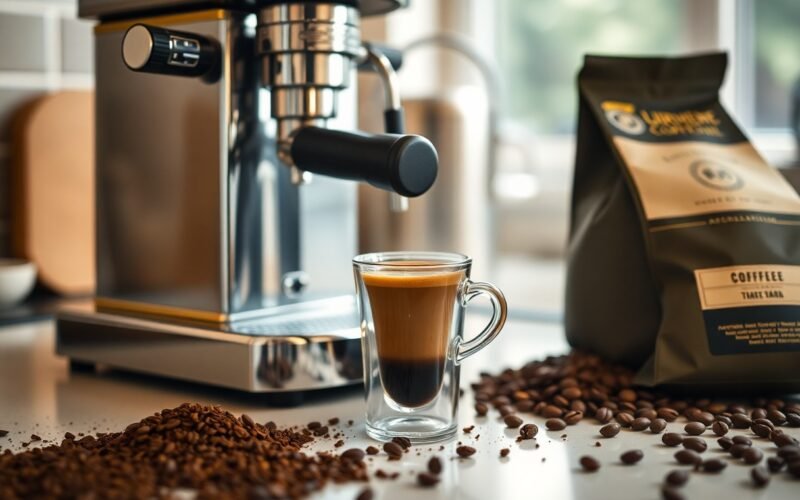Most coffee lovers dream of brewing the perfect espresso at home, but achieving that barista-quality flavor can feel daunting. With the right techniques and tools, you can transform your kitchen into a café-quality espresso station. In this guide, you’ll learn how to select the best beans, master your grind size, and control your brewing process for espresso that’s rich and aromatic. If you find yourself stuck or need specific tips, check out the community discussions on Need expert advice for espresso at home (not getting …. Let’s dive in!
Key Takeaways:
- Invest in a quality espresso machine and grinder, as the equipment significantly impacts the flavor and consistency of your espresso.
- Use freshly roasted, high-quality coffee beans and pay attention to the grind size, as it plays a vital role in the extraction process.
- Master the art of tamping and brewing time to achieve the perfect shot; practice will help you refine your technique for optimal results.

The Art of Selecting Quality Coffee Beans
Your coffee bean selection plays a pivotal role in the espresso you brew at home. Quality beans, sourced from reputable farms and roasters, will ensure a richer flavor profile and consistency in your shots. Look for beans with clear origins, and always select those labeled as specialty grade. The fresher the beans, the better the taste—so aim to buy them in small batches that you can consume within a couple of weeks, ensuring maximum flavor potential.
Identifying the Best Bean Varieties
Two main coffee varieties dominate the market: Arabica and Robusta. Arabica beans tend to deliver a sweeter, more aromatic profile, while Robusta beans are often bolder, with a higher caffeine content. Seek out beans that boast distinct flavor notes like chocolate, fruit, or floral, as these characteristics are indicative of high-quality coffee. Exploring blends or single-origin offerings from regions like Ethiopia or Colombia can also lead you to exceptional choices.
Understanding Roast Levels and Flavor Profiles
Roast level significantly impacts the flavor nuances of your espresso. Light roasts often highlight the origin’s brightness and acidity, while medium roasts provide a balanced sweetness and body. Dark roasts offer deeper flavors, with hints of chocolate and caramel. Each roast presents unique taste experiences, so experimenting with various levels will help you identify your personal preference.
Diving deeper into roast levels, a light roast, typically characterized by a light brown color without oil, will preserve the beans’ distinctive flavor nuances, allowing fruity or floral notes to emerge. Medium roasts introduce a balance of acidity and body, appealing to those who appreciate a sweeter profile without sacrificing complexity. Dark roasts, often oily and dark in color, emphasize heavier, bittersweet flavors — ideal if you prefer a bold and robust espresso. By understanding these profiles, you can tailor your bean selection to align with your taste preferences and achieve the perfect brew.
Mastering the Espresso Machine
Understanding how to operate your espresso machine effectively is integral to brewing a café-quality coffee at home. Mastering your machine entails familiarizing yourself with its various settings and functionalities, which contribute significantly to the extraction process. This guide offers valuable insights, including How to Brew a Better Cup of Coffee at Home (Without … an espresso machine’s impact on flavor.
Essential Features to Look For in an Espresso Machine
Choosing the right espresso machine involves identifying imperative features that align with your coffee preferences. Look for machines with a stable temperature control system, a durable portafilter, and a reliable pump pressure mechanism. Options that provide a steam wand for frothing milk can elevate your espresso-based drinks. After ensuring the machine meets these imperative criteria, you’ll be ready to brew like a pro.
Maintenance Tips for Optimal Performance
Regular maintenance is fundamental to achieving consistent espresso quality. Always clean your machine’s brew group and water reservoir after each use, ensuring to descale your machine periodically to prevent mineral buildup that can affect performance. Check gasket seals and replace them if needed. After following these maintenance tips regularly, your espresso machine will continue to perform at its best.
- Clean brew group to avoid flavor transfer.
- Descale water reservoir to enhance efficiency.
- Replace worn gasket seals to prevent leaks.
To dive further into maintenance for optimal espresso, pay attention to the length of your brewing cycle. A machine that pulls shots faster than average might need cleaning, while slower brewing may indicate clogs. Regularly check your grinder settings for consistency; uneven grind can compromise your espresso. After maintaining these aspects, you’ll ensure each shot remains rich and flavorful.
- Monitor brewing cycle to maintain quality.
- Check grinder settings for consistency.
- Clean all brew components regularly.
Precision Grinding: The Key to Perfect Espresso
A precise grind is the foundation of exceptional espresso. The grind size directly impacts extraction, flavor, and crema. With the right grind, you can manipulate brew time and pressure to achieve a rich, balanced shot of espresso. Achieving uniform particle size allows for a consistent extraction, ensuring that you capture the essence of your carefully selected beans. This precision in grinding transforms your coffee moments into a delightful experience, enabling you to brew like an expert roaster.
Choosing the Right Grinder: Burr vs. Blade
Opting for a grinder can be daunting, particularly the choice between burr and blade grinders. Burr grinders offer consistent particle size, which is important for espresso, while blade grinders tend to produce uneven grinds that can hinder extraction. Burr grinders, available in both flat and conical varieties, are more expensive but deliver superior results. Investing in a burr grinder ultimately enhances your espresso quality, making it well worth the expense.
Ideal Grind Size for Espresso Brewing
The ideal grind size for espresso is often likened to that of table salt – fine yet not powdery. Achieving this perfect texture is transformative; it allows water to flow through the coffee puck evenly, extracting flavors and oils optimally. This results in a shot that boasts a rich, velvety crema and a well-rounded flavor profile. More specifically, a grind size between 200 to 300 microns strikes the right balance between flavor extraction and brewing time, typically around 25-30 seconds. Consequently, a finer grind encourages slower extraction while ensuring that your espresso isn’t over-extracted, which can lead to a bitter taste. Take the time to experiment with your grind setting for the ideal extraction that suits your palate.
The Alchemy of Brewing: Techniques for Success
The mastery of espresso brewing lies in the fine balance of art and science. Each step, from selecting your beans to pulling the perfect shot, contributes to the ultimate experience. Experiment with water temperature, grind size, and brewing time to create a customized cup. Paying close attention to these variables not only enhances the flavor but also empowers you to unlock the unique characteristics of your coffee. Embrace the process, trust your palate, and don’t shy away from adjusting and refining your techniques until you achieve espresso perfection.
Measuring and Tamping: The Golden Ratio
Your espresso’s flavor hinges on precision—aim for the golden ratio of 1:2, where you use 18 grams of coffee to yield approximately 36 grams of espresso. Consistent measurement ensures repeatability in flavor, while a proper tamping pressure of around 30 pounds creates an even coffee bed that promotes optimal extraction. Too loose, and you risk watery shots; too tight, and you may over-extract. Achieving this balance is key to unlocking the richness and complexity of your brew.
Adjusting Variables: Brew Time and Pressure Control
Brew time and pressure play significant roles in the flavor profile of your espresso. Typically, a brewing time of 25-30 seconds, with a pressure of 9 bars, yields the best results. Altering these variables subtly influences extraction, affecting both bitterness and acidity. A shorter brew time can highlight fruity notes, while a longer extraction may draw out deeper, richer flavors. Fine-tuning these parameters allows you to craft an espresso that perfectly complements your taste.
Experimentation with brew time and pressure is an exciting journey in espresso-making. For instance, reducing the brew time by a second or two can shift the flavor profile towards a more acidic, vibrant experience, showcasing the coffee’s inherent characteristics. Conversely, extending the brew time might enhance the body and savoriness of your espresso but risks introducing bitterness if overdone. Keep a journal of your adjustments; this way, you can document which combinations resonate best with your palate, establishing a blueprint for your perfect cup each time.
Crafting the Signature Espresso Shot
Your espresso shot is your personal signature, an intricate blend of flavor, aroma, and texture that showcases your unique brewing style. To elevate your at-home espresso experience, investigate the fine details of balance and intensity. Utilize techniques shared by expert coffee roasters, such as optimal bean selection and precise brewing temperatures. If you’re still perfecting your craft, check out 3 Ways to Make Espresso at Home Without a Fancy Machine for simplified methods to enhance your skill set.
Recognizing the Four Stages of Extraction
Successful extraction consists of four stages: the initial ‘blonding’ phase, where the coffee oils emerge, the middle ‘golden’ stage, known for rich flavor, the ‘dark phase’ featuring bitter notes, and finally the pre-extraction end. Identifying these stages helps you adjust your grind size, dose, and brew time accordingly. You want to capture the right balance of sweetness and acidity in your shot to achieve espresso perfection.
Troubleshooting Common Issues for Peak Flavor
A perfect espresso shot can sometimes feel elusive, especially with common challenges like channeling, bitterness, or sourness affecting your brew. Identifying the source of these issues is crucial for improvement. Variable factors like grind size, tamping pressure, and water temperature can lead to inconsistent results.
When troubleshooting, consider your grind size first; a grind that is too coarse can cause under-extraction, resulting in a sour taste, while a fine grind might lead to over-extraction and bitterness. Pay attention to your tamping pressure as well; if too light, water flows through too quickly, while over-tamping can trap water. Adjust brewing temperatures; higher temperatures might accentuate bitterness. Conduct small adjustments, and take notes of each trial to find your sweet spot. Maintaining consistent water quality is also key, as impurities can alter flavors significantly.
Summing up
Upon reflecting on how to brew espresso like expert coffee roasters at home, it’s clear that mastering the process involves attention to detail and practice. You should focus on your choice of coffee beans, precise grinding, and achieving the right water temperature and pressure. Consistency is key, so ensure you develop a routine that allows you to refine your technique. With patience and the right tools, you can elevate your espresso-making skills and enjoy café-quality results in the comfort of your own kitchen.
Q: What equipment do I need to brew espresso at home like an expert?
A: To brew espresso at home with expert-level quality, the important equipment includes a high-quality espresso machine and a burr grinder. The espresso machine should have a good pressure system (ideally 9 bars) for optimal extraction. A reliable burr grinder is important for achieving a consistent grind size, which affects the extraction. Additional tools include a tamper for compressing the coffee grounds, a scale to measure your coffee and water accurately, and a shot glass for monitoring extraction time. Optional accessories like a milk frother can enhance your brewing experience, especially for lattes and cappuccinos.
Q: How do I choose the right coffee beans for brewing espresso?
A: Choosing the right coffee beans is key to brewing great espresso. Look for beans that are specifically labeled as espresso roast; these are generally darker roasts that can withstand the high pressure during brewing. Single-origin beans or blends from reputable roasters often yield the best flavors. It’s advisable to purchase whole beans and grind them just before brewing for maximum freshness. When dicking out, consider the flavor profiles you enjoy, such as fruity or nutty notes, and experiment with different beans to discover what you prefer.
Q: What is the ideal brewing time and pressure for espresso, and how can I achieve it at home?
A: The ideal brewing time for espresso is typically around 25 to 30 seconds, and maintaining a pressure of 9 bars during extraction is important for achieving the right flavor and crema. To achieve this at home, ensure your espresso machine is properly calibrated and that you’re using the right grind size; it should be fine but not too powdery. Adjust your tamping pressure; a uniform, firm tamp will help create a consistent resistance to the water during brewing. Monitoring the flow of the espresso can also help; if it’s too fast, try a finer grind or a firmer tamp, and if it’s too slow, adjust to a coarser grind or a lighter tamp.




